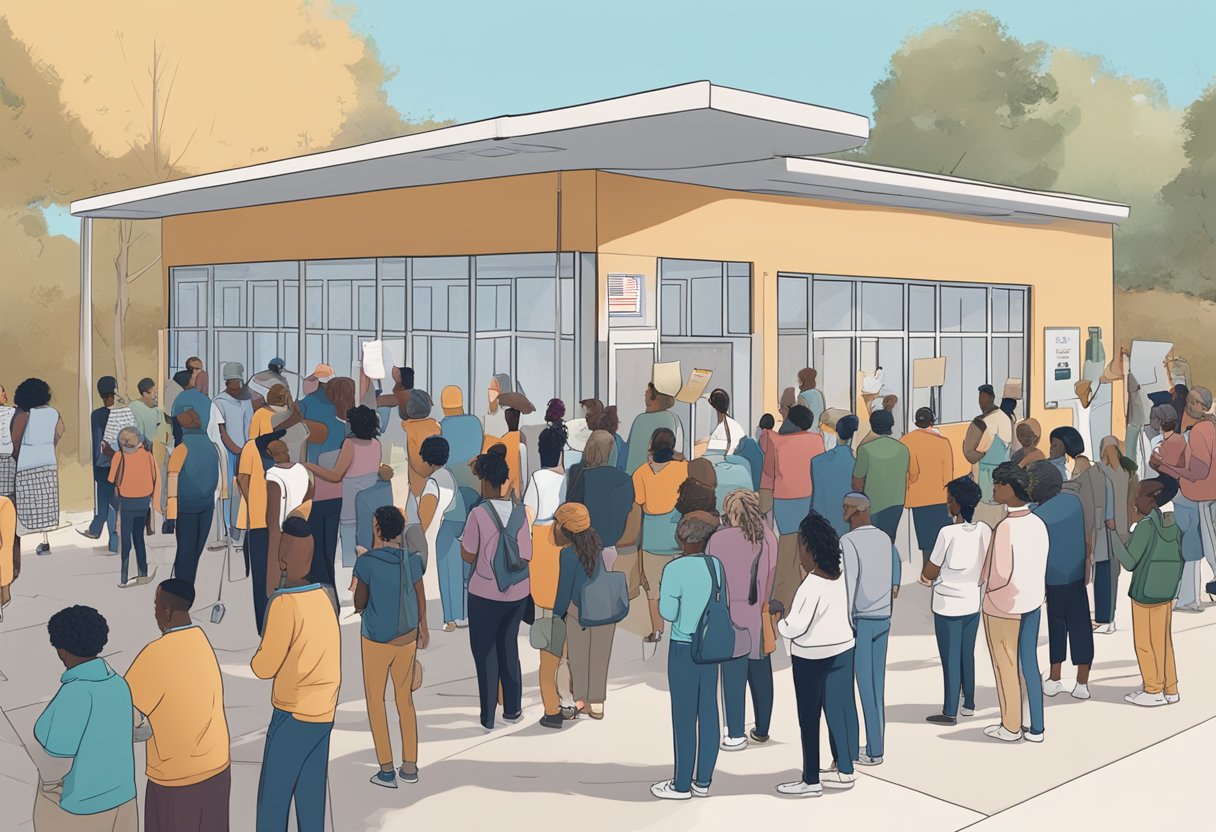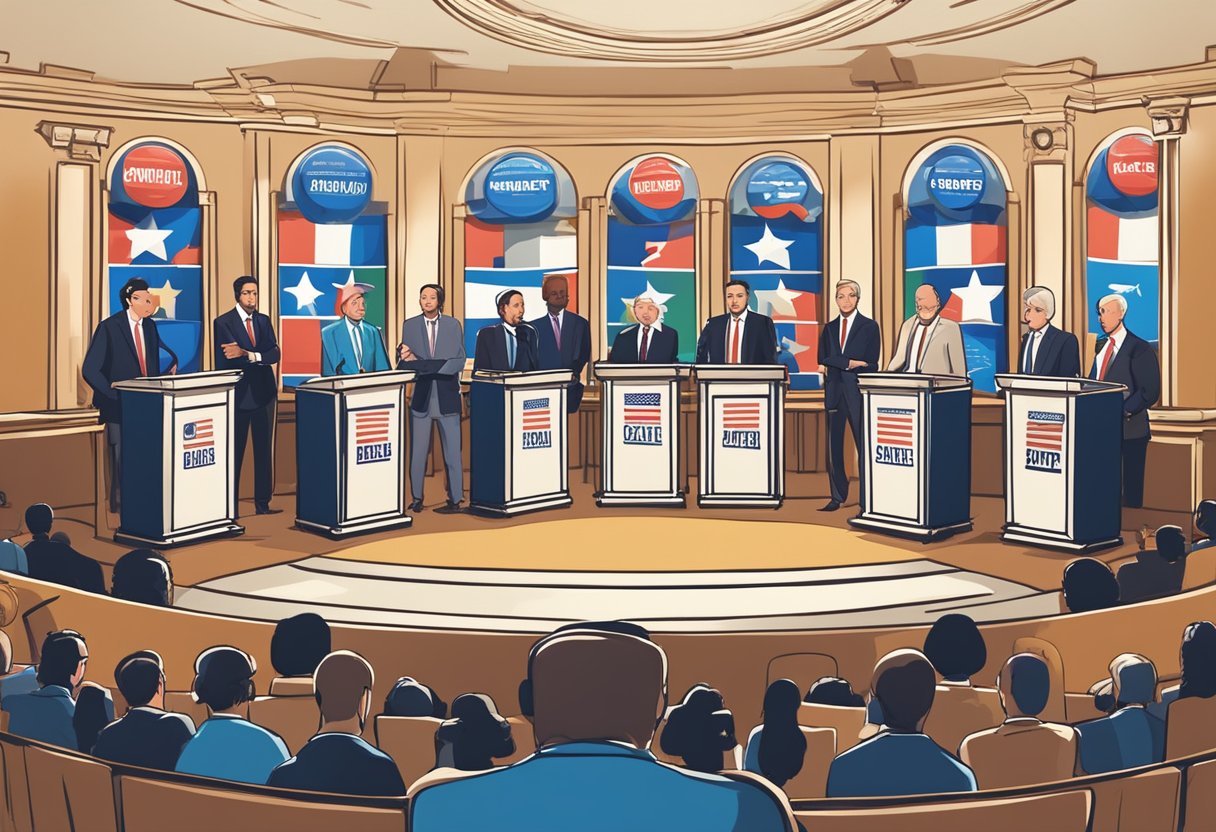The 2024 US Presidential election is steadily approaching, and with it comes the heightened interest in the political landscape of America. This significant event, which will mark the 60th quadrennial election, not only determines the future leader of the country but also stands as an opportunity for bettors to engage in election betting. In the United States, the Presidential election involves both a popular vote and the Electoral College system, and it is the candidate with the majority of electoral votes who ultimately claims the presidency.
Analyzing the odds and polls in the buildup to election day is crucial for anyone looking to place informed bets. Betting on the election is not just about predicting the winner; it also extends to individual state results, party nominations, and various political occurrences that resonate with voters. While the process may seem complex, understanding the odds, the mechanics of the election, and the current political atmosphere can give bettors an edge.
Key Takeaways
- The 2024 US Presidential election is a pivotal event for bettors and the nation, as it decides the next president.
- Proficient betting on the election involves comprehension of the electoral process, odds, and the political climate.
- Insightful analysis and historical context are imperative for making informed betting decisions on the election’s outcomes.
Need Help Beating the Bookies?
Our expert betting tipsters have been taking cash off the bookies since 2014! If you need a helping hand with winning then why not check them out?
Browse Our Tipsters
Punter’s Profit Pro
One of the Most Reliable and Consistent Horse Racing Tipsters at Betting Gods
Visit PROFILEUnderstanding the US Electoral Process

The United States electoral process is a complex system that involves several key stages, from party primaries to the election in the Electoral College. Each stage plays a vital role in determining who will become the next President of the United States.
Primaries and Caucuses
Primaries and caucuses are the initial steps where members of the Democratic Party and the Republican Party select their respective presidential candidates. Individual states hold these events, which vary in format, with primaries being direct statewide voting and caucuses being local gatherings where votes are often determined through discussions and subsequent votes.
- Super Tuesday is a significant event in the primary season, a day when a large number of states hold their primaries or caucuses simultaneously.
Party Conventions
Following the primaries and caucuses, each party holds a convention. It is here that delegates officially nominate their party’s candidate for the presidency. The conventions also serve to unify the party behind their candidates and propel them into the general election campaign phase with increased momentum.
- The Democratic National Convention and the Republican National Convention finalize their presidential and vice-presidential nominees through a delegate voting process.
General Election and Electoral College
The general election is when voters across the nation cast their ballots for their preferred presidential candidates. However, it’s the Electoral College system that ultimately decides the winner. Each state is assigned a certain number of electors based on its congressional representation — the combination of its senators and representatives in the Congress.
- A total of 538 electors form the Electoral College, and a majority of 270 electoral votes is required to win the presidency.
- While most states have a “winner-takes-all” approach in awarding their electoral votes, Maine and Nebraska use a proportional system.
Role of the Senate and House of Representatives
The Senate and House of Representatives, the two houses of Congress, have distinct roles in the event of an electoral deadlock or when approving Vice Presidential picks.
- The House of Representatives elects the President if no candidate secures a majority in the Electoral College.
- The Senate is responsible for electing the Vice President under the same circumstances.
Moreover, the newly elected Congress certifies the Electoral College results in a joint session held in early January following the general election.
Key Political Parties and Candidates

As the 2024 United States presidential election approaches, bettors are keeping a close eye on key political parties and candidates. The field is crowded with hopefuls from the Democratic and Republican parties, as well as a notable presence of third-party and independent candidates.
Democratic Candidates
The Democratic race has several prominent figures that gamblers should watch. Joe Biden, the incumbent president, is speculated to run for a second term although he has not made a formal announcement. Names like Kamala Harris, current Vice President, and Pete Buttigieg, Secretary of Transportation, are mentioned as potential candidates. Others rumored or expressing interest include:
- Michelle Obama, though she has never held political office, her popularity adds weight to her potential candidacy.
- Gavin Newsom, serving as the governor of California, is seen as a rising star in the Democratic Party.
- Bernie Sanders, who has maintained a significant following since his prior presidential bids, may emerge as a candidate once more.
Republican Candidates
The Republican field features a mix of established politicians and fresh faces. Key candidates include:
- Donald Trump, former president, has made clear his intention to run again.
- Ron DeSantis, the governor of Florida, is seen as a strong contender with growing popularity.
- Nikki Haley, former UN Ambassador, has announced her candidacy and is building her campaign.
- Mike Pence, the former vice president, is also a potential candidate with a loyal conservative base.
- Ted Cruz, a prominent senator from Texas, has been a fixture in national politics and may seek the nomination.
Third-Party and Independent Candidates
Third-party and independent candidates often face uphill battles but can sway pivotal votes. Some of the key figures in this space include:
- Jill Stein, who has been a Green Party nominee in previous elections, could represent the party once again.
- Tucker Carlson, the television personality, has been mentioned as a potential independent candidate due to his influence and following.
This guide will help bettors consider the political landscape and the candidates shaping the 2024 US Election.
Analyzing Betting Odds and Polls
In the landscape of political betting, understanding how to interpret betting odds and polling data is crucial for those looking to gauge the potential outcomes of the 2024 US election.
How Betting Odds Work
Betting odds provide a numerical representation of the likelihood of various election results, as determined by bookmakers or betting markets. When bettors see odds listed as a positive or negative number, such as +150 or -200, these figures indicate the potential return on a bet. For instance, +150 means a $100 bet would return $150 in profit if successful. These figures can suggest who the favorites and underdogs are in the race, with underdogs having higher positive numbers and favorites having lower negative numbers or small positive numbers.
Understanding Polling Data
Polling data reflects the preferences of surveyed voters. Polls are categorized as safe, leans, tilt, or too close to predict when regarding a candidate’s lead in a given demographic or region. However, polls are snapshots in time and can be affected by margins of error or shifting public opinion. They inform, but do not determine, betting odds. Reliable polling data should come from reputable sources using scientific sampling methods and should consider the race’s dynamics, including the performance in swing states.
Predictive Markets and Forecasts
Predictive markets such as PredictIt and the Iowa Electronic Markets allow participants to buy shares in political outcomes. Priced from $0 to $1, these shares rise or fall in value based on the collective wisdom of the market participants. These markets, along with regulated betting markets and sports betting apps, offer an alternative to traditional polls by aggregating beliefs about a future event’s probability. While not without their imperfections, they have been used as real-time indices of election probabilities, reflecting the ebb and flow of campaign seasons.
By analyzing these data points, bettors and observers can form a more nuanced view of the election landscape, considering how odds and polls may influence or reflect each other.
Important Election Dynamics
Understanding key elements such as debate impacts, the swing states’ influence, and the role of the vice president is crucial in grasping the mechanics of the 2024 US Presidential Election. These components could significantly affect the electoral votes distribution and shape the outcome of the race.
Impact of Debates
Debates play an essential role in shaping public perception. Effective debate performances can alter the momentum of an election campaign, swinging undecided voters and tightening or widening the margin of victory. Presidential debates put candidates’ policies, responses under pressure, and ability to lead in the national spotlight, which often influences the popular vote.
Influence of Swing States
- Swing States’ Power: Certain states, known as swing states, hold disproportionate power due to their undecided voter base. Winning these states can be pivotal to securing the necessary 270 electoral votes for victory.
- Key Swing States in 2024:
- Florida: A perennial battleground with a significant number of electoral votes.
- Pennsylvania: Known for its ability to swing between parties in recent elections.
- Michigan and Wisconsin: Both have shown they can be the tipping point in a close race.
The election campaign strategies often focus on these pivotal regions, as candidates pour in resources to sway the electorate in their favor.
Role of the Vice President
Vice President Kamala Harris’ role in the 2024 election may influence both the strategy and dynamics of the campaign. The vice president often acts as a key surrogate, rallying support and articulating the administration’s accomplishments. Their presence on the campaign trail and potential debate performance can contribute to shaping the narrative and rallying the base, which is particularly critical in close races where every vote counts.
Critical Issues and Voter Sentiment
The 2024 US Election hinges on key issues that resonate with voters’ immediate concerns and long-term aspirations. People’s sentiment towards economic stability, social justice, and environmental sustainability will shape the electoral landscape.
Economic Concerns: Inflation and Jobs
Inflation remains a top concern as voters feel the impact on their daily lives. With rising costs of goods and services, candidates’ plans to manage inflation are scrutinized for their potential to restore affordability. Employment is equally pivotal, with voters expecting policies that promote job growth and economic opportunity.
- Inflation: Data reflects an uptrend in consumer prices, affecting household budgets.
- Jobs: The employment rate and quality of new jobs are indicators of economic health.
Social Issues: Immigration and Civil Rights
Immigration policy shapes the nation’s demographic and economic landscape. Voters consider border control and the treatment of immigrants when casting their ballots. Civil Rights, encompassing voting rights, abortion access, and equality, remain at the forefront of the social agenda.
- Immigration: Policies range from border security to pathways for citizenship.
- Civil Rights: Debates over voting legislation, reproductive rights, and equal protection under the law influence voter sentiment.
Environmental Policy: Climate Change
The urgency of climate change drives demand for robust environmental policies. Voters evaluate candidates’ strategies to reduce carbon emissions and transition to sustainable energy sources. Concern for the environment extends into broader cultural discussions about responsibility and innovation.
- Climate Change: Commitment to international climate agreements and investment in green technologies are critical measures.
Voters’ preferences in these critical areas will play a significant role in determining the election’s outcome.
Historical Context and Comparisons
This section provides a critical analysis of the historical patterns observed in past US presidential elections, examines voting trends over the years, and highlights some of the most influential presidential campaigns.
Past Presidential Elections
Historically, the 2024 US presidential election is the 60th in the cycle. Notably, the precedent was set by Ulysses S. Grant, who, in the 19th century, was elected as the 18th president. Reflecting on his presidency provides insights into how far the federal election process has evolved. Grant’s election was heavily influenced by his Civil War hero status, showcasing the impact a candidate’s background can have on voter perception. Indeed, the persona of a candidate can often weigh as heavily as their policies.
Historical Voting Trends
Analysis of voting trends uncovers a complex tapestry of the evolving American political landscape. For instance, Woodrow Wilson’s presidency denoted a shift in the progressive era, representing a move toward more internationalist policies. Moreover, observing shifts from one political party to another during different epochs points to underlying socio-economic sentiments. For example:
- Democrats: Held sway during periods requiring significant federal government intervention like the Great Depression.
- Republicans: Rose in periods advocating for deregulation and conservative fiscal policies, epitomized by the Reagan Era.
Notable Presidential Campaigns
Notable campaigns throughout history have shaped the strategies employed in the lead-up to the 2024 US presidential election. One such campaign that might influence future ones is by Barack Obama in 2008, which was characterized by an adept use of social media and grassroots organizing. The same principles could apply should former First Lady Michelle Obama decide to run. Her campaign would likely utilize a sophisticated mix of traditional campaigning and digital outreach.
Each historical precedent sets a stage that informs and guides current election strategies, ensuring a dynamic and ever-changing political battleground.
Campaign Strategies and Voter Outreach
The success of election campaigns hinges primarily on effective voter outreach and strategic planning. Finance, social media influence, and grassroots support play crucial roles in this domain.
Campaign Finance and Advertising
Campaign finance serves as the lifeblood of any political effort aiming for the Oval Office. Conservative and GOP entities, along with their counterparts, allocate substantial resources to media buys, particularly in swing states. Advertising strategies often include:
- Television: The traditional mainstay, reaching a broad demographic.
- Digital Media: Tailored ads targeting specific voter groups, often based on extensive data analytics.
Party conventions generate significant funding surges, as donors rally to support their candidate’s final push toward Election Day.
The Role of Social Media
Social media enhances campaigns‘ abilities to engage with voters directly and cost-effectively. Facebook, Twitter, and Instagram are potent tools that:
- Broadcast campaign messaging.
- Mobilize supporters.
- Counteract negative press.
Campaigns leverage these platforms for fundraising and to amplify key moments, like debates or the announcement of running mates.
Grassroots Movements and Volunteering
Grassroots efforts are critical for fostering community support and embody the campaign’s volunteer spirit. They typically involve:
- Door-to-door canvassing.
- Phone banks.
- Voter registration drives.
These tactics are instrumental in energizing the base, with volunteers often being the campaign’s face in local communities. Election campaigns rely on this foundation to establish a presence beyond digital outreach and traditional advertising.
Legal and Regulatory Aspects
In betting on US elections, the landscape is shaped by a complex interplay of election laws, court decisions, and state versus federal regulatory environments.
Election Laws and Supreme Court Decisions
The US Supreme Court plays a crucial role in interpreting election laws and has had a significant impact on how elections are conducted. Notably, the 14th Amendment underscores the importance of equal protection under the law, effectively influencing how votes are counted and the overall fairness of elections. Supreme Court decisions often become benchmarks for legal precedents related to elections.
State Regulations on Betting
Different states have varied stances on election betting. For instance, West Virginia briefly allowed betting on the 2020 US Presidential elections before retracting it. On the other hand, regulated sportsbook operators like DraftKings in some jurisdictions, may provide betting odds on a range of events, but typically avoid the domain of US federal elections due to regulatory uncertainties.
Federal vs State Electoral Interventions
When it comes to election interference, both federal and state entities play roles in prevention and investigation. While the federal government, through agencies like the FBI, focuses on guarding against external threats, states maintain the integrity of their individual electoral processes. Despite such measures, regulated markets in countries like Canada and Europe often feature betting platforms such as Betfair, which may offer US president odds without being subject to US regulations.
The Path Ahead: Projections and Possibilities
As the race to the White House intensifies, projections for the 2024 US Election begin to take shape. Experts analyze multiple factors to predict the winning party, focusing on past election data, current polls, and demographic shifts. The battleground states remain pivotal in tilting the electoral scale.
Battleground States:
These states notoriously swing between parties and are crucial for a win. They typically have a margin of less than 5%:
- Florida
- Pennsylvania
- Michigan
- Wisconsin
Likely Contenders:
The field of potential candidates is narrowing, and forecasters are keeping a close eye on prominent figures like Glenn Youngkin and Chris Sununu. Their appeal in battleground states could be decisive and is being factored into the probabilities.
Electoral College Map:
The map represents a continuing puzzle. It requires 270 electoral votes to claim victory. Analysts carefully watch states that are categorized as:
- Toss-up: Margin <5%
- Leaning: Margin <10%
- Likely: Margin <15%
- Safe: Margin 15% or higher
Each candidate’s strategy includes securing their likely states while making inroads into the toss-ups and leaning territories.
Presidential Election Odds:
The odds, derived from various sources like betting markets, provide a dynamic view of each candidate’s chances. They are not predictive but reflect public sentiment and can influence campaign strategies.
In essence, the journey to the White House in 2024 is shaping up to be a tapestry of strategic calculations, with pivotal states and potential new entrants influencing the high-stakes electoral contest. The political landscape remains fluid, with each update potentially reshaping the path ahead.
Frequently Asked Questions
With the 2024 US Presidential Election approaching, bettors are seeking reliable information on how to place informed bets. This section addresses common queries related to predictions, odds, and the mechanics of political betting.
What are the latest predictions for the 2024 presidential election?
Predictions fluctuate as the political landscape evolves. As of now, oddsmakers have closely analyzed potential candidates’ chances, with some placing former President Donald Trump and incumbent President Joe Biden among the favorites.
Where can I find the odds for the next U.S. president in 2024?
The odds for the 2024 presidential election can be found on various betting platforms and political analysis sites. Odds are typically presented based on current events, campaigns, and the perceived popularity of the candidates.
Which site offers the best analysis for 2024 presidential election betting?
Several sites provide comprehensive betting guides and analyses for the 2024 election. Bettors should look for platforms that offer up-to-date information, expert commentary, and a track record of accuracy.
How can I legally bet on the 2024 Presidential election?
To bet legally on the 2024 Presidential election, one must reside in a country or state where political betting is permitted. Bettors should use licensed and regulated online sportsbooks or betting exchanges.
What do different betting odds formats mean in political betting?
Betting odds formats, such as American, Decimal, and Fractional, represent the probability of an event happening and the potential return on a bet. For example, at -110 odds (American), you would need to bet $110 to win $100, showing a slight favorite.
How does PredictIt work for betting on political events?
PredictIt operates as a prediction market allowing users to buy and sell shares relating to political outcomes. The price of these shares corresponds to the market’s belief in the likelihood of a particular event occurring.






